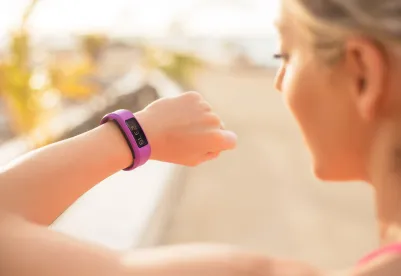This follows the blog article posted November 26, “Connection and Innovation Take Center Stage at the Patient ENGAGE Conference” and is the second feature regarding the MedCity ENGAGE conference Nov. 6-7 in San Diego. Here, we focus on the aspects of the conference that explored the impact of technology on patient engagement, from wearables to DNA sequencing, to apps used by insureds to quit smoking while reducing insurance premiums in the process.
Leveraging Wearables for Increased Engagement
Wearable technology presents new and innovative tools for improving health and increasing patient engagement. Speakers from HonorHealth, Spry Health, and Withings Healthcare discussed the increasing prevalence of wearables in healthcare, including use in clinical trials and in the course of medical treatment. While the use of wearables has been more common among affluent and healthy individuals in the past, adoption of wearable technology is undergoing a paradigm shift to address the needs of the chronically ill. Providers are using wearables to assist in managing chronic diseases by allowing for individuals to track fitness indicators (heart rate, calories burned, steps taken, etc.) as well as monitor adherence to a doctor’s orders and even assist in the detection of diseases. FDA regulations that govern the approval process for technology involved in diagnosing health conditions have not kept pace with the evolution of wearable technology. The regulations have had a narrow focus on the aspect of the technology that track certain health metrics, without taking into account the robust data analytics component of wearables.
Further research will need to be conducted regarding the use of wearables to facilitate medical treatment in order for clinicians to feel comfortable using them for that purpose. Wearables currently used for health-related purposes, such as Apple Watch or FitBit, are consumer products, and to maximize adoption of wearables for use in treatment, wearables will need to qualify as medical-grade devices. Wearable technology will also need to become more user friendly and less conspicuous when worn, in order to become an integral part of care management and patient monitoring in the future.
From Genealogy Tests to the Genetics App Store
Helix is a personal genomics company spun out of Illumina that empowers individuals to seek medical treatment based on an analysis of their personal genetic make-up. Justin Kao, co-founder and senior vice president for business development and partnerships at Helix reported that 4-5% of people have an indicator in their genome that can be acted on now; for example, a person with FH (familial hypercholesterolemia) can start taking statins to reduce cholesterol levels. Nutrigenomics can facilitate weight loss because certain genes make their holders more likely to tie BMI to sugary beverages or saturated fat, which influences dietary choices. Helix is of the view that population health management initiatives can benefit substantially from conducting genome sequencing of large population groups, and that individuals are open to participating in initiatives when incentivized to do so. For example, Helix partnered with Renown Health, a not-for-profit healthcare network in Reno Nevada, to invite individuals to participate in a study that would involve sequencing their genome and pairing it with their EMR, and 10,000 individuals signed up in the first 4 days, with a free genealogy report as an incentive for participating.
Helix is currently only a cash-pay business and has not looked at the payor market yet, but health systems are not waiting for insurance coverage to incorporate genome analysis into care: Geisinger, Mt. Sinai, and the Mayo Clinic have launched various programs to perform carrier screenings and assess genetic factors in connection with designing patient treatment plans. It costs $1,000 – 2,000 to conduct a full genetic test, and $700 to limit the results to the protein-coding genes. Helix provides a genetic counselor and offers a user-friendly genetics portal; primary care physicians would generally be able to make use of this data as part of routine patient care. Will the curious be penalized in the insurance market? The Genetic Information Nondiscrimination Act (“GINA”) prohibits the information from being used to charge higher healthcare premiums, but it does not apply to life insurance. It may be best to buy the policy before laying bare your genome…
Where Do Patient-Reported Outcomes Fit in Value-based Care?
Patient-Reported Outcomes are a key component of advancing patient engagement. A panel comprised of the Director of Specialty Care and Clinical Innovation, for LAC+USC Medical Center, the Founder of Epharmix, the Chief Commercial Officer of Click Therapeutics, and the Chief Engagement and Dissemination Officer for the Patient-Centered Outcomes Research Institute (PCORI) discussed the benefits of monitoring and improving patient health through patient-reported outcomes (“PROs”), and the challenges of motivating patients to consistently engage and interact with a PRO program. In one compelling example of a reimbursement model incorporating PROs, a company might encourage its employees to engage with a PRO-driven app to treat patient conditions that directly impact insurance premiums (e.g., a smoking cessation program), and the company would share cost savings for successful outcomes (e.g., lowered premiums for patients who quit smoking) with the provider of the PRO-driven app. One could imagine applying this novel reimbursement paradigm to a wide range of treatment programs. The panel was inspiring, and we will be tracking further developments in this space.
Next-Generation Healthcare Technology Companies
The MedCity conference concluded with the “Pitch Perfect” contest, a series of brief presentations by ten start-ups describing their innovations and approach to boosting patient engagement. The new ideas, products, and services were intriguing and well-designed. For example, the Medumo application guides patients by directing them on their medication regime, providing reminders in relation to their rehabilitation after surgery, and following up on scheduled doctor visits, via a user-friendly telephone reminder system—coined as a “turn-by-turn care navigation and instructional support to help . . . patients successfully complete and recover from their care.” Another similar smartphone-type application was Litesprite, which provides a game to help improve mental health by promoting, for example, meditation and relaxation in an effort to combat anxiety and depression. OcuMedic presented on a state of the art bandage lens, which provides a timed delivery of drugs to the eyes to help healing from cataract and LASIK surgery, as a replacement for eye drops. Another precision product was presented by GenXys, which offers precision prescribing software for the management of an individual’s conditions. GenXys uses computer algorithms to tailor medication options based on an individual’s unique genetic makeup and personal information.






 />i
/>i
